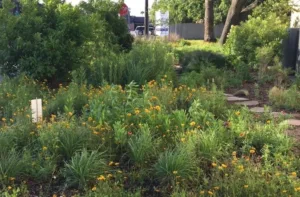 Wildscaping is a way of designing your home’s landscape to attract and benefit wildlife, especially birds and butterflies, by providing the required food, water, and shelter. The ‘food’ component can best be provided through the use of plants that are native to your area; afterall, wildlife and plants have evolved together for many thousands of years. Wildscaping is also a way each of us can help offset the disappearance of wildlife habitat caused by development.
Wildscaping is a way of designing your home’s landscape to attract and benefit wildlife, especially birds and butterflies, by providing the required food, water, and shelter. The ‘food’ component can best be provided through the use of plants that are native to your area; afterall, wildlife and plants have evolved together for many thousands of years. Wildscaping is also a way each of us can help offset the disappearance of wildlife habitat caused by development.
One of the best resources for wildscaping in Texas is the book Texas Wildscapes: Gardening for Wildlife (Noreen Damude and Kelly Conrad Bender, Texas Parks and Wildlife Press, 1999). This book lists native plants to attract wildlife for each of the 10 ecological regions of Texas, as well as what wildlife you might expect to attract.-
To learn more about how to work with your HOA, visit Wildscaping & Your HOA.
